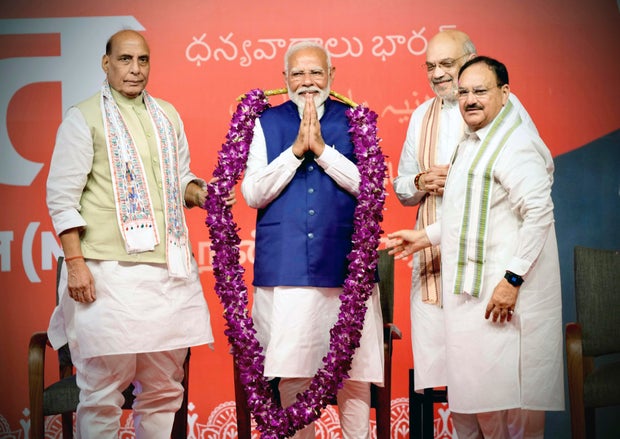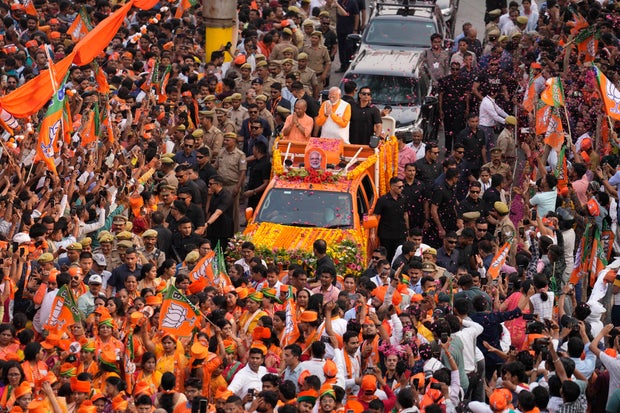Indian Prime Minister Narendra Modi took office for a third consecutive term on Sunday, but it could bring more challenges for the popular but polarizing leader than his last decade in power.
His Hindu nationalist Bharatiya Janata Party, which won overwhelmingly in 2014 and 2019, failed to secure a majority to govern alone this time, although his National Democratic Alliance coalition with the BJP and other parties won enough seats for a slim parliamentary majority.
Modi and members of his cabinet took the oath, administered by President Draupadi Murmu, at India’s presidential palace, Rashtrapati Bhavan, in New Delhi.
Needing the support of his regional allies to maintain his power means that Modi may have to adapt to a style of governance with which he has little experience or desire.
Manish Swarup/AP
Modi, 73, is only the second Indian prime minister to win a third consecutive term. He presided over a rapidly growing economy while promoting Hindu nationalism.
To his supporters, he is an extraordinary figure who has improved India’s standing in the world, helped make its economy the fifth largest in the world and streamlined the country’s vast social welfare program, which serves about 60% of the population. For some, he may even be more than human.
But to critics, he is a cult leader who has eroded India’s democracy and promoted divisive policies that target Muslims, who make up 14% of the country’s population. They say he has also increasingly used strong-arm tactics to subdue political opponents, pressure independent media outlets and suppress dissent.
Modi’s government has rejected such accusations and claims that democracy is flourishing.
Political analysts say Modi’s victory was driven by social welfare programs that provided benefits from food to housing and by strident Hindu nationalism that consolidated the Hindu vote for his party. Hindus make up 80% of India’s population.
The economy is growing at 7% and more than 500 million Indians have opened bank accounts during Modi’s tenure, but that growth has not created enough jobs and inequality has worsened under his government, according to some economists.
Modi began his election campaign by promising to transform India into a developed country by 2047 and focused on highlighting his administration’s welfare policies and robust digital infrastructure that have benefited millions of Indians.
But as the campaign progressed, he increasingly resorted to anti-Muslim rhetoric, calling them “infiltrators” and making references to a Hindu nationalist claim that Muslims were overtaking the Hindu population by having more children. Modi also accused the opposition of favoring the minority community.
Conspicuous piety has been a centerpiece of Modi’s brand, but he has also begun to suggest that he was chosen by God.
“When my mother was alive, I believed that I was born biologically. After she passed away, as I reflected on all my experiences, I was convinced that God had sent me,” he said in a TV interview during the campaign.
In January, he realized a long-held Hindu nationalist ambition by opening a controversial temple on the site of a razed mosque.
Rajesh Kumar/AP
After the campaign ended, Modi went to a Hindu spiritual site for a televised 45-hour meditation retreat. Most Indian TV channels broadcast the event for hours.
Born in 1950 to a low-caste family in western Gujarat state, at a young age, Modi joined the Rashtriya Swayamsevak Sangh, a right-wing paramilitary group that has long been accused of fueling hatred against Muslims. RSS is the ideological parent of Modi’s BJP.
The tea seller’s son got his first big political break in 2001, becoming the state’s chief minister. A few months later, anti-Muslim riots ravaged the region, killing at least 1,000 people. There were suspicions that Modi quietly supported the riots, but he denied the allegations.
In 2005, the U.S. revoked Modi’s visa, citing concerns that he did not act to stop communal violence. An investigation approved by the Indian Supreme Court later acquitted Modi, but the stain of the dark moment remained.
Thirteen years later, Modi led his Hindu nationalist party to a spectacular victory in the 2014 national elections after promising sweeping reforms to boost India’s weakened economy.
But Modi’s critics and opponents say his Hindu-first policy has generated intolerance, hate speech and blatant attacks on minorities, especially Muslims, who make up 14% of India’s 1.4 billion people.
Months after securing a second term in 2019, his government revoked the special status of disputed Kashmir, the country’s only Muslim-majority state, and divided it into two federally governed territories. His government approved a law which grants citizenship to religious minorities in Muslim countries in the region, but excludes Muslims.
Decisions like these have made Modi immensely popular among his die-hard supporters, who hail him as the defender of the Hindu majority and see India emerging as a Hindu-majority state.
Modi has spent his political life capitalizing on religious tensions for political gain, said Christophe Jaffrelot, a political scientist and expert on Modi and the Hindu right. During his time as state leader, he pioneered the adoption of Hindu nationalism, unlike anything seen before in Indian politics.
“That style remained. It was invented in Gujarat and is now a national brand,” said Jaffrelot.
bol co
jogo de terror online
novela sbt ao vivo
wishlist
musica terra seca
taça png

























